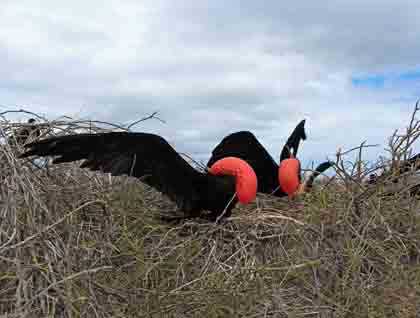Sun rises at 6:05 am, the morning is a bit overcast on the second day of our expedition around these enchanted islands. We set off to visit North Seymour. Despite its small size, this island is full of life.
At the moment we disembark, it starts to rain, but a few minutes later it stops, and soon the sun is burning intensely and the sky is free of clouds. As I say to our guests, “Welcome to the equator, a place where weather is unpredictable,” and that is true.
The highlight of this place is the number of marine birds that inhabit it, particularly the magnificent and great frigate birds and the blue footed boobies. The local vegetation is rather dry, mostly small bushes and trees towards the interior, but it is here that most of the frigate bird colony is found. These birds have the largest wingspan-to-weight ratio, and their flight skills make them the real masters of the air. Along the path, we encounter several blue-footed boobies, some of which are looking after very young chicks. Another emblematic species that is found here is the land iguana; they create a lovely contrast with their yellow scales against the dull colored ground! The endemic marine iguanas are found along the shoreline; where they can be close to the marine algae that they exclusively feed on. It is truly remarkable how all of these creatures show fearlessness towards us humans as we walk through their colonies or territories, a characteristic that makes the Galapagos Islands unique on this planet.
We finish our walk seeing all what we expected to see—it was an amazing morning.
In the afternoon, we navigate westwards to our new destination: the red island known as Rabida. The landscape here is very different to North Seymour. Rabida is small but tall, and its lavas are reddish due to the presence of iron oxide. It is time to enjoy the Galapagos waters, so our guests have plenty of choices today. Some decide to explore the coastline underwater by glass bottom boat; our deep water snorkelers jump in to find the wonders of the local underwater world, while others prefer to practice their snorkeling skills from the beach. It is a real treat to share the beach with a colony of Galapagos sea lions! A little later, we disembark once again on Rabida Island for a walk. The scenery is dominated by a native incense tree, also called “palo santo”. As we venture inland, we spot several land bird species, like the Galapagos mockingbird, several Darwin finch species, doves and a flycatcher. At a higher point we make a stop, from which we could see the outlines of distant Isabela and Fernandina; these are the youngest and westernmost islands of this archipelago. As the sun begins to set and the day comes to an end, so it is time to return on board, everyone with an expression of happiness in their faces, and deep in their spirits a sensation of quietness.









